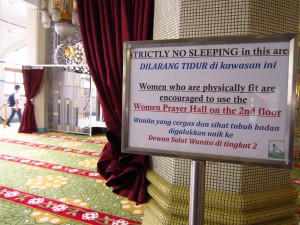This article was originally posted on Aquila Style and slightly edited for Muslimah Media Watch.
A video that emphasises the determination and willpower of a disabled person overlooks the need for institutions to adopt more inclusive policies.
 |
| Arif Ali/AFP |
“How is your situation with attending the mosque?” begins a video by Kuwaiti preacher Mishary Al-Kharaz, before he introduces us to his “friend in Yemen”.
The video shows Kamal, a young man with a “handicap”, as he enters a mosque, prays sitting on a chair and then goes up to the second floor after the maghrib prayer to attend a Qur’an memorisation class.
All this despite the fact that he walks with difficulty on level flooring, has to crawl up the stairs, and struggles to recite Qur’anic verses as his voice is unclear. He also has to depend on someone to walk him home from the mosque with the help of a lamp as nights get totally dark there and there are no streetlights.
Judging by the comments on the video in my social media feeds, there is an outpouring of sympathy for Kamal. People make du’a for him because he has to expend much more energy to worship, and he does even more than the average able-bodied person.
However, I think the video was made mostly to make able-bodied people feel guilty if they don’t pray five times a day in the mosque. The video misses out on the structural barriers faced by disabled people – especially in Yemen – such as the lack of affordable and suitable wheelchairs (or other kinds of supportive equipment), the lack of lifts in buildings, and the seemingly ambivalent attitude of the other Muslims around him (why is the Qur’an memorisation class still held on the second storey and not moved to the first?)
The video also does nothing to raise awareness about those similar to Kamal, as he is described simply as someone with a “handicap”. In fact, he has cerebral palsy, a neurological condition that affects movement, coordination, hearing, sight and learning to various degrees. While there is no cure, it can be improved through medication or therapy.
What about other kinds of “handicaps”? What about those who require ramps or lifts to enter the mosque, Braille Qur’ans or sign language for sermons?
While the video commendably address the issue of accessibility in the mosques for the disabled, it does so from a male perspective. What if Kamal were Kamila: as a woman would she be able to even enter the mosque? And if she could, would she have a decent prayer space, be able to hear the sermon, and have access to Qur’an classes? In some smaller mosques in Singapore, for example, women are told to avoid the mosque during Friday prayers (although larger mosques may set aside a smaller space for them).
However, I think the video was made mostly to make able-bodied people feel guilty if they don’t pray five times a day in the mosque. The video misses out on the structural barriers faced by disabled people – especially in Yemen – such as the lack of affordable and suitable wheelchairs (or other kinds of supportive equipment), the lack of lifts in buildings, and the seemingly ambivalent attitude of the other Muslims around him (why is the Qur’an memorisation class still held on the second storey and not moved to the first?)
The video also does nothing to raise awareness about those similar to Kamal, as he is described simply as someone with a “handicap”. In fact, he has cerebral palsy, a neurological condition that affects movement, coordination, hearing, sight and learning to various degrees. While there is no cure, it can be improved through medication or therapy.
What about other kinds of “handicaps”? What about those who require ramps or lifts to enter the mosque, Braille Qur’ans or sign language for sermons?
While the video commendably address the issue of accessibility in the mosques for the disabled, it does so from a male perspective. What if Kamal were Kamila: as a woman would she be able to even enter the mosque? And if she could, would she have a decent prayer space, be able to hear the sermon, and have access to Qur’an classes? In some smaller mosques in Singapore, for example, women are told to avoid the mosque during Friday prayers (although larger mosques may set aside a smaller space for them).
 |
| A sign found in Singapore’s Sultan Mosque encouraging fit and able-bodied women to use the second floor. |
If Kamila were allowed access to this Yemeni mosque, where would her praying space be? In Singapore (and many other places), many of the women’s spaces are a floor or two above the main prayer hall. Without a lift, would Kamila have to crawl up the stairs every time she came to pray? In recent years, a historic mosque in Singapore has taken into account the needs of their aging congregation: a new tent-like space has been reserved on the main floor for women who are not able to climb the stairs to the second floor.
Surely we cannot continue to emphasise an individual’s determination in the face of barriers. We must take into account that disability and gender come together to produce unique sites of oppression. And mosques need to change to accommodate their congregation, too.
Otherwise, who is the mosque for but only able-bodied men?
No comments:
Post a Comment